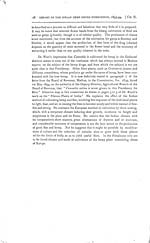Download files
Individual page:
Thumbnail gallery: Grid view | List view

CH. II.] REPORT OF THE INDIAN HEMP DRUGS COMMISSION, 1893-94. 17
justified in correcting
that description. Dr. Prain has omitted to notice the
fact that the plant varies in the colour of its stem. The dark
variety may
be, and probably is, an accidental difference merely. But it will
be found that
the replies to the Commission's questions from Nepal and the
memorandum from
the Special Assistant Excise Commissioner in Mysore, Mr. McDonnell
(para. IIIa),
lay stress on the difference, and
attribute to the darker variety stronger narcotic
properties. The fact is also noticed by witnesses in different
parts of India, and
the Commission have themselves observed the variety of colour in
the plants. And,
secondly, in describing the male plant, Dr. Prain writes that there
is no trace
of even a rudimentary female flower. The Commission found at
Khandwa hemp
plants having the general appearance of males, but containing a few
female
flowers or seeds. These were quite distinct from the female plants
with abnor-
mal male flowers, which were also present in the Khandwa
cultivation, and which
are mentioned in Dr. Prain's description. The cultivators of
Khandwa appeared
also to recognize at least one variety of the pure male plant to
which they gave
a name of its own (Sheoria); but it has not been possible to
detect any essential
difference between it and the ordinary male plant, though specimens
were for-
warded to Dr. King. On this subject reference is invited to the
description of
the cultivation in the Central Provinces and Bombay.
Existence of races of the
hemp
plant yielding the different products.
22. The third point
(c) is raised in Dr. Watt's letter (Vol. III
Appendices).
The function of the
Commission is to test by the
information they have collected the views therein
expressed regarding the probable existence of races capable of
yielding as a
speciality the different products—fibre, ganja, charas, and bhang. The only differ-
ences recognized in the plant by the people are between the
wild and the culti-
vated plant, the male and the female, and the
varieties of the male and female
plant already referred to. The inherent potentiality of the seed to
develop a
plant closely resembling the parents must be admitted, but there is
no evidence of
racial speciality or differentiation of the decided sort suggested
by the examples
quoted by Dr. Watt.
Does the fibre plant yield narcotics?
23. The question is
capable of being handled more definitely in the forms
in
which points (d) and
(e) are stated. First, it has to
be seen whether the plant cultivated for fibre
yields the narcotic. The evidence on this point is positive and
unmistak-
able. The female plant cultivated for fibre in Kumaon yields a very
considerable
amount of charas, and its flower heads, after being handled to
collect the charas,
can be, and sometimes are, smoked as ganja. The fact that it is the
female plant
which yields the drug seems to be very strong evidence that the
functional pro-
cess by which the narcotic is secreted in the fibre plant is the
same as that by
which ganja is produced in the plant cultivated for that product.
There is also
a considerable body of evidence that the wild plant not only yields
the narcotic
as held in its leaves, but is also capable of yielding, and does
yield to treatment
during growth and manipulation on maturity, the products charas and
ganja.
Does the narcotic plant yield fibre?
24. There is no evidence
that the hemp plant is cultivated for fibre anywhere
except at a considerable
elevation on the Hima-
layas; and as regards point (e), Sind appears
to be the only place where the plant cultivated for the narcotic
yields fibre.
There the object of the cultivation is bhang, and the extraction of
the fibre
5
Set display mode to: Large image | Zoom image | Transcription
Images and transcriptions on this page, including medium image downloads, may be used under the Creative Commons Attribution 4.0 International Licence unless otherwise stated. ![]()
| India Papers > Medicine - Drugs > Report of the Indian Hemp Drugs Commission, 1894-1895 > Volume I > (36) Page 17 |
|---|
| Permanent URL | https://digital.nls.uk/74574140 |
|---|---|
| Description | Chapter II, cont. |
| Description | [Volume 1]: Report. |
|---|---|
| Attribution and copyright: |
|



![Plate [1]](https://deriv.nls.uk/dcn4/7443/74434755.4.jpg)
